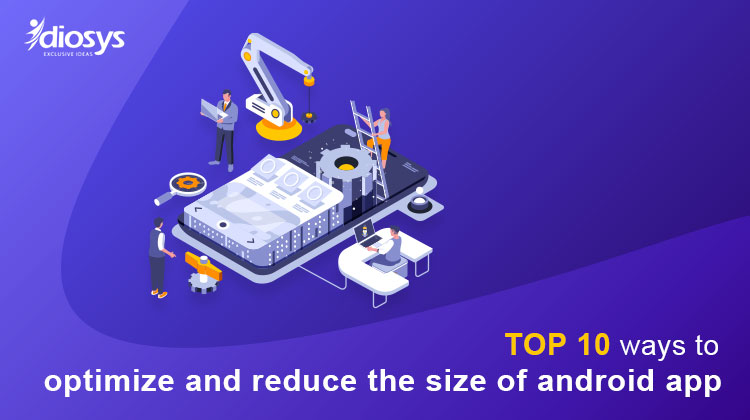
14 Jun, 2021
You are on this page probably because you are an Android app developer who loves to stay updated with the latest app development trends or you’re tired of developing mammoth-sized APK files that hardly get installed on your Android phone. However, big sized apps not only take a huge download time but are also difficult to navigate. Today, as web development techniques are growing leaps and bounds, there are multiple solutions to this very common and relevant issue. You can hire an app development company for your web development and ask for their suggestions. But, if you know some of the best techniques, it’ll help you to boost your web presence. Here are the top 10 ways to optimize and reduce the size of the android app. Read on to know these points in detail and see the transformation.
There are some apps which we cannot do without, nor can we get rid of. We grow a constant love-hate relationship with these apps. We praise their design and maybe smooth navigability but in the end, curse their sheer size. We never stop dreaming about ways to have more apps that will occupy less amount of space in our devices. This is the scenario of most Android users worldwide and here we will try to provide the best possible solutions.
The three main reasons for bigger sized apps are the highest growing feature sets, the increasing UX expectations and the support these provide for a wide range of screen sizes and densities. These are some features we love but in the end, face highly increased data consumption. So, is it possible to reduce the app sizes without compromising their functionality or features? Let’s quickly check out!
- Image Optimization: You can reduce the app size by reducing the sizes of images. The jpg and .png images can be easily converted to .webp web image format, which results in the reduction of image size without compromising the quality a bit. You will get the effects such as the lossy compression like .jpg and the transparency like .png in .webp web image format and therefore, no need to worry. There are multiple tools available online to help you perform this task. Also, you can use the aapt tool to crunch .png images and reduce the file size on your website.
- Redundant Code Removal: It is essential to know a code’s footprint within a redundant system where it is automatically generated. This way, you can get rid of the redundant code and reduce the space to some extent. Usually, the protocol buffer tools can occupy a lot of space and these do not do any good to your app. Hence, all you need to do is remove such repetitive codes so that your app size remains optimum without the oppression of such superfluous parts. You can discuss this with your developers about this task and they will definitely help you out.
- Dead Code Elimination: Just like redundant codes, dead code elimination is necessary for reducing the size of your app. For instance, APK files can make your app bigger in size as the load speed, memory and power depend on it. The bulk will only expand if you store any unused or inoperative code kept just for the sake of keeping. Thankfully, dead code elimination does not have any negative impact on the functionality of your app and instead, removing them enhances the quality of the source code. As the introduction of bugs is prevented, maintaining a healthy app will be easier.
- Unused Resources and Class: Lint, a part of Android Studio, is a static code analyzer. The main purpose of this code analyzer is to detect resources in the res/ folder not referenced in the code. These resources detected by Lint are mainly unused and hence, removing these can be beneficial. Here, the best part of this code analyzer is that it skips scanning the assets/ folder or the assets a code references via reflection and never removes resources on its own unless you remove them.
- Reuse of Resources: Reusing is a smart technique to reduce the app file size and instead of removing, you can reuse the resources. If you have a discreet resource to define variations in an image pertaining to shades, tints, and orientation, you can reuse it for customizing other images. Apart from reducing the app size, it keeps the scrolling performance of an app optimum. For the higher versions, your developer can use the android:tint and tintMode attribute and for the lower ones, ColorFilter makes a suitable option.
- Resources from Libraries: To deliver the best usability and versatility, external libraries have no alternative. Google Play Services is one such example of external libraries that are used to retrieve autotranslations of app text. Also, Android Support Library is another suitable example, which is used to up the user experience on dated devices. Now, these libraries come with loads of methods and objects that you won’t probably need. If you hire Android app developer, discuss this issue and find the best way to remove them.
- Specific Screen Densities: There is a vast range of screen densities supported by Android such as ldpi, tvdpi, mdpi, hdpi, xhdpi, xxhdpi, and xxxhdpi. Now, definitely, you do not need all of them for your app. Hence, ask your developer to choose specific screen densities for your app. Before fixing your specific screen densities and reducing your app size, all you need to do is make a survey to determine the percentage of users with devices that have specific densities.
- Size of Native Binaries: If your app runs on native code, there are multiple techniques of reducing the native and Java codebase as well as shrink the size of the release version. You can use the arm-eabi-strip tool in Android NDK to get rid of useless debug symbols. Or, you can set android:extractNativeLibs=”false” to save the extraction of native libraries. This way, PackageManager will be restricted from copying .so files from APK to the file system.
- Avoidance of Enumerations: Enums can be highly tricky and can accumulate at a fast speed, especially if there are shared libraries or complex systems. Hence, it is always beneficial to steer clear of enumerations. You can convert enumerations into integers by using the ProGuard and the @IntDef annotation. As a result, your app size will reduce a lot without compromising the functionality.
- Multiple APK Files: APK files can also be tricky as these can sometimes come with content that gets downloaded without any use. Add-ons like additional languages are not necessary most of the times but these are downloaded automatically. Apart from consuming data, these also enlarge the application and result in poor user satisfaction. You can optimize this function using the Android App Bundles.
Now that you know the above 10 ways to optimize and reduce the size of an android app, go ahead and make the most of them. Are you looking for an Android app development company to build your business app? If the answer is a yes, feel free to get in touch with us right away! We, Idiosys Technologies, are one of the highly acclaimed web and app development companies providing advanced and target-specific Android apps to help you grow your online presence. We have a team of Android developers and experts, who are highly skilled, experienced and updated to get you exactly what you have been tried so far. So, do not wait any further, simply contact us to know the best deal for you.
YOU MAY ALSO READ:
FLUTTER VS REACT NATIVE FIND THE BEST ONE
CHOOSE THE BEST ONE NODE.JS VS JAVASCRIPT
